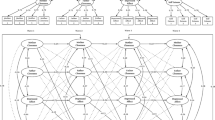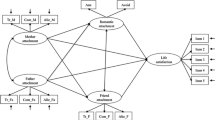Abstract
This study explored the relative influence of adolescents' perceptions of their attachment relationships with their mothers, fathers, and friends on three measures of self-esteem. The sample consisted of 493 New Zealand adolescents ranging from 13 to 19 years of age. Two dimensions of the attachment relationship were assessed: the utilization of emotional support and proximity, and the quality of affect. The major findings were as follows: utilization of emotional support and proximity from mothers, fathers, and friends was minimally related to overall self-esteem, coping abilities, and social competence. The quality of affect toward mothers and fathers was significantly related only to social competence. These findings suggest that adolescent self-esteem is more strongly associated with the quality of affect toward parents and friends than with the utilization of these target figures for support or proximity. The notion that parents and friends may contribute to different facets of self-esteem is discussed.
Similar content being viewed by others
References
Ainsworth, M. D. S. (1989). Attachment beyond infancy.Am. Psychol. 44: 709–716.
Armsden, G. C. (1986). Attachment to parents and peers in late adolescence: Relationships to affective status, self-esteem and coping with loss, threat and challenge. (Doctoral Dissertation, University of Washington, 1986.)Dissert. Abstracts Int. 47(4-B): 1751–1752.
Armsden, G. C., and Greenberg, M. T. (1987). The inventory of parent and peer attachment: Individual differences and their relationship to psychological well-being in adolescence.J. Youth Adolescence, 16: 427–451.
Berndt, T. J. (1982). The features and effects of friendship in early adolescence.Child Development, 53: 1447–1460.
Bowlby, J. (1982).Attachment and Loss: Vol. 1. Attachment (2nd ed.). Basic Books, New York.
Bretherton, I. (1985). Attachment theory: Retrospect and prospect.Monogr. Soc. Res. Child Develop. 50: 3–35.
Burke, R. J., and Weir, T. (1978). Benefits to adolescents of helping relationships with parents and peers.Psychol. Rep. 42: 1175–1184.
Cassidy, J. (1988). Child-mother attachment and the self in six year olds.Child Develop. 59: 121–134.
Cubis, J., Lewin, T., and Dawes, F. (1989). Australian adolescents' perceptions of their parents.Austra. NZ J. Psychiat. 23: 35–47.
Department of Statistics. (1991).National Summary of 1991 Census of Population and Dwellings. Government Printer, Wellington.
De Wuffel, F. J. (1986).Attachment beyond childhood. Doctoral Dissertation, University of Nijmegen (Netherlands), ISBN 90-9001241-9.
Dusek, J. B., and Flaherty, J. F. (1981). The development of self-concept during the adolescent years.Monogr. Soc. Res. Child Develop. 46: 1–67.
Easterbrooks, M. A., and Lamb, M. E. (1979). The relationship between the quality of infant-mother attachment and infant competence in initial encounters with peers.Child Develop. 50: 350–387.
Elley, W. B., and Irving, J. C. (1985). The Elley-Irving socio-economic index 1981 census revision.NZ J. Educat. Studies 20: 115–128.
Gecas, V. (1972). Parental behaviour and contextual variations in adolescent self esteem.Sociometry 35: 332–345.
Gecas, V., and Schwalbe, M. L. (1986). Parental behaviour and adolescent self esteem.J Marriage Family 48: 37–46.
Greenberg, M. T., Seigal, J. M., and Leitch, C. J. (1983). The nature and importance of attachment relationships to parents and peers during adolescence.J. Youth Adolesc. 12: 373–386.
Grotevant, H. D., and Cooper, C. R. (1986). Individuation in family relationships.Human Develop. 29: 82–100.
Hoffman, M. A., Ushpiz, V., and Levy-Shiff, R. (1988). Social support and self esteem in adolescence.J. Youth Adolesc. 17: 307–316.
Hunter, F. T., and Youniss, J. (1982). Changes in functions of three relations during adolescence.Develop. Psychol. 18: 806–811.
Kalish, R. A., and Knudson, F. W. (1976). Attachment versus disengagement: A life-span conceptualisation.Human Develop. 19: 171–181.
Kobak, R. R., and Sceery, A. (1988). Attachment in late adolescence: Working models, affect regulation, and representations of self and others.Child Develop. 59: 135–146.
Kon, I. S., and Losenkov, V. A. (1978). Friendship in adolescence: Values and behaviour.J. Marriage Family 40: 143–155.
Kroger, J. (1983). Relationships during adolescence: A developmental study of New Zealand youths.NZ J. Educat. Studies 18: 115–126.
LaGaipa, J. J. (1979). A developmental study of the meaning of friendship in adolescence.J. Adolesc. 2: 201–213.
LeCroy, C. (1988). Parent-adolescent intimacy: Impact on adolescent functioning.Adolescence 23: 137–147.
Lempers, J. D., and Clarke-Lempers, D. S. (1992). Young, middle, and late adolescents comparisons of the functional importance of five significant relationships.J. Youth Adolesc. 21: 54–96.
Monge, R. H. (1973). Developmental trends in factors of adolescent self-concept.Develop. Psychol. 8: 382–393.
O'Donnell, W. J. (1976). Adolescent self esteem related to feelings toward parents and peers.J. Youth Adolesc. 5: 179–185.
Offer, D., Ostrov, E., and Howard, K. I. (1977). The self-image of adolescents: A study of four cultures.J. Youth Adolesc. 6: 265–280.
Offer, D., Ostrov, E., and Howard, K. I. (1981).The Adolescent: A Psychological Self Portrait. Basic Books, New York.
Offer, D., Ostrov, E., and Howard, K. I. (1982).The Offer Self Image Questionnaire for Adolescents: A Manual (3rd ed.) Michael Reese Hospital, Chicago.
Papini, D. R., Sebby, R. A., and Clark, S. (1989). Affective quality of family relations and adolescent identity exploration.Adolescence 24: 457–466.
Parkes, C. M., and Stevenson-Hinde, J. (1982). (eds.).The Place of Attachment in Human Behaviour. Basic Books, New York.
Paterson, J. (1993). Adolescent perceptions of attachment: Parents, friends, and impact on self esteem. Unpublished doctoral dissertation, University of Auckland, New Zealand.
Rice, K. O. (1990). Attachment in adolescence: A narrative and meta-analytic review.J. Youth Adolesc. 19: 511–538.
Rosenberg, M. (1965).Society and Adolescent Self Image. Princeton University Press, Princeton, NJ.
Rosenberg, M. (1979).Conceiving the Self. Basic Books, New York.
Ryan, R. M., and Lynch, J. H. (1989). Emotional autonomy versus detachment: Revisiting the vicissitudes of adolescence and young adulthood.Child Develop. 60: 340–356.
Sroufe, L. A., Fox, N. E., and Pancake, V. R. (1983). Attachment and dependency in developmental perspective.Child Develop. 54: 1615–1627.
Waters, E., Wippman, J., and Sroufe, L. A. (1979). Attachment, positive affect and competence in the peer group: Two studies in construct validity.Child Develop. 50: 821–829.
Weiss, R. S. (1982). Attachment in adult life. In Parkes, C. M., and Stevenson-Hinde, J. (eds.),The Place of Attachment in Human Behaviour. Basic Books, New York.
Youniss, J. (1983). Social construction of adolescence by adolescents and parents: Individuation to mutuality. In Grotevant, H. D., and Cooper, C. R. (eds.),Adolescent Development in the Family: New Directions for Child Development. Jossey-Bass, Chicago.
Youniss, J., and Ketterlinus, R. (1987). Communication and connectedness in mother and father adolescent relationships.J. Youth Adolesc. 16: 265–280.
Youniss, J., and Smollar, J. (1985).Adolescents' Relationships with Mothers, Fathers and Friends. University of Chicago Press, Chicago.
Author information
Authors and Affiliations
Additional information
This research is based on the first author's doctoral dissertation at the University of Auckland.
Received Ph.D. from the University of Auckland, Auckland, New Zealand. Research interests are adolescent development and the development of children's health beliefs and behaviors. To whom reprint requests should be addressed at School of Occupatinal Therapy, Private Bag 92006, Auckland Institute of Technology, Auckland 1020, New Zealand.
Received Ph.D. from the University of Canterbury. Main interests are in life span developmental psychology, and the development of low birthweight babies.
Received Ph.D. from the Australian National University. Interests lie within life span developmental psychology and early cognitive development.
Rights and permissions
About this article
Cite this article
Paterson, J., Pryor, J. & Field, J. Adolescent attachment to parents and friends in relation to aspects of self-esteem. J Youth Adolescence 24, 365–376 (1995). https://doi.org/10.1007/BF01537602
Received:
Accepted:
Issue Date:
DOI: https://doi.org/10.1007/BF01537602




